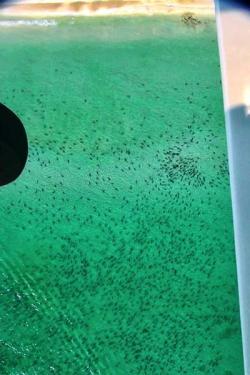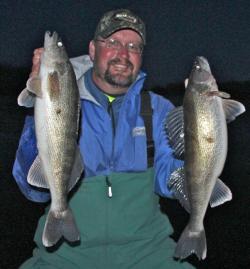Plans Unveiled for a New National Conservation Destination
from The Fishing Wire
America’s Wildlife Museum and Aquarium envisioned to be the foremost destination for anyone who loves and protects the outdoors
Springfield, Mo. – Johnny Morris, founder of Bass Pro Shops and leading conservationist, in partnership with noted conservationists from around the world, has unveiled plans behind America’s Wildlife Museum and Aquarium in Springfield, Missouri, envisioned as the most elaborate conservation attraction of its kind for fish and wildlife conservation. Scheduled to open in spring 2016, the 315,000-square-foot educational experience will consist of multiple thematic attractions and exhibits on a scale unlike anything else in the world.
Anchored by an all-new world-class aquarium, the massive facility brings together a variety of compelling opportunities for visitors of all ages to engage with nature like never before. Through immersive environments and incredible live animal habitats, the experience aims to showcase the beauty of wildlife while celebrating the critical role hunters and anglers play in wildlife conservation by honoring past accomplishments and ongoing efforts.
“Responsible hunters and anglers are often the unsung heroes in conservation despite playing a significant role,” said Johnny Morris, the visionary behind the experience. “Our vision is to create a world-class experience that celebrates hunting, fishing, and conservation in Springfield where half of the U.S. population lives within a day’s drive.”
When fully realized, the attraction will consist of an all-new 1.3-million-gallon aquarium adventure showcasing 35,000 live fish, mammals, reptiles and birds in an immersive tour through the world’s marine habitats; a wildlife museum that brings visitors eye-to-eye with amazing mammal specimens from North America, Africa and the Arctic; and a conservation education center for youth programs, conservation groups and events.
Construction on the project – funded entirely by private dollars, primarily from the nonprofit Johnny Morris Foundation – is underway with a grand opening anticipated in spring 2016. Additional details will be announced prior to the opening. Specific components include:
All new aquarium adventure and Fishing Heritage Hall
The centerpiece is an entirely new world-class aquarium adventure designed by renowned aquarium architect Michael Olesak that plunges guests into a thrilling tour of the world’s oceans, lakes and streams, bringing them eye-to-eye with more than 35,000 animals. Visitors will encounter sharks, rays, jellies, eels and more in fully immersive environments that transport visitors to some of the wildest aquatic ecosystems on earth.
• New Fishing Heritage Hall – Visitors will first enter the breathtaking 60,000-square-foot entry hall, home to a dramatic 300,000-gallon “open ocean” habitat teeming with saltwater marine life including mahi-mahi. Guests can become awe-inspired by a collection of boats fishing legends were made on, including the very first Tracker and Ranger boats, as well as historical boats used by Jimmy Buffet, and Ernest Hemingway. In addition, guests can view renowned author and angler Zane Grey’s famous boat, moved to the Museum from New Zealand, where the first 1,000-pound marlin was caught. The Hall also serves as the ticketing and lobby area.
• New aquarium adventure – Designed to transport visitors to some of the world’s greatest undersea environments, visitors will discover an elaborate trail system that winds in and around marine habitats teeming with life, including a sunken shipwreck, colorful coral reefs, tropical coasts, underwater caves, steamy rainforests, freshwater swamps and more. Throughout the more than one-mile journey, visitors can get closer than ever before with surprises around every turn including opportunities to get “hands-on” with a variety of ocean animals. The aquarium celebrates the diversity of all sea life, especially game fish, and highlights the need to conserve the beautiful ecosystems they call home.
• New International Fishing Hall of Fame – The new International Game Fish Association Fishing Hall of Fame will highlight some of the sport’s most accomplished men and women through interactive exhibits, personal artifacts and masterfully recreated replicas of world-record fish mounts from both freshwater and saltwater species.
The International Game Fish Association, which represents members in more than 125 countries, has hosted this interactive collection at its global headquarters in Dania Beach, Florida, for the past 16 years. Relocating the exhibit to the new Museum will provide substantially more exposure and engage more of IGFA’s members and the public.
“We’re thrilled with the opportunity to join a much larger conservation vision that celebrates our sport and the wildlife we love,” said IGFA President Rob Kramer. “Partnering with long-time friend and supporter Johnny Morris on this experience is a win-win for our organization and our mission of game fish conservation.”
All-New wildlife museum and Hunting Heritage Hall
Walk amongst the largest land mammals on earth, go eye-to-eye with the Arctic’s top predator and discover some of the most spectacular game animals on the planet in this sprawling 50,000- square-foot showcase of amazing mammals from around the world.
• Hunting Heritage Hall – Meticulously recreated lifelike environments will educate visitors about the importance of conserving the icons of the animal kingdom. Inspired by Johnny Morris’ visits to the great natural history museums of America, this all-new showcase takes the concept even further with lifelike animal diorama displays surrounded by recreated natural settings including hand-painted murals, foliage, waterfalls, lighting, sound, wind, and temperature settings to transport visitors to many of the world’s most diverse habitats. Special features include the King of Bucks, the largest collection of trophy white-tailed deer in the world, and Art Dubbs’ record collection of sheep from around the globe set amongst a dramatic rocky mountain cliff. Displays highlight the work of America’s leading conservation groups including Ducks Unlimited, Rocky Mountain Elk Foundation, National Wild Turkey Federation and many others.
• Boone and Crockett Club’s world-famous National Collection of Heads and Horns – Experience a part of history through more than 40 historically significant North American big game mammals that originally helped bring conservation to the forefront of public awareness in America when it debuted at New York’s Bronx Zoo in 1922.
Established by the Boone and Crockett Club, a wildlife conservation organization founded by Theodore Roosevelt, the collection originally exposed thousands to big game animals at a time when their numbers were dwindling, drawing national attention to the plight of wildlife after decades of unregulated harvest and irresponsible land use practices. Amazed by the natural beauty, an inspired and determined public ensured subsequent legislation proposed by Club members to protect wildlife and habitats were given top priority.
Today, guests can still marvel at the bears, bison, caribou, elks, walrus and other big game animals, many of which are considered world-record holders for their size. The collection is relocating from the Buffalo Bill Historical Center in Cody, Wyoming, to once again introduce this historic and influential collection to new audiences.
“The Boone and Crockett Club is honored to contribute our historic collection to what will surely become the most elaborate conservation education attraction in the world,” said Tony Schoonen, the club’s chief of staff. “Johnny’s Museum builds on our rich legacy of conservation to ensure future generations will join our efforts to protect wildlife.”
John A. and Genny Morris Conservation Education Center
The conservation leaders of today and tomorrow already gather together at the completed 50,000-square-foot Conservation Education Center, which connects to the Museum facility.
• The Wonders of the Ozarks Learning Facility School, a comprehensive outdoor learning school operated in partnership with Springfield Public Schools, Missouri Department of Conservation and Bass Pro Shops, is a national model for outdoors education. The school educates and inspires future conservation leaders by offering lucky fifth-grade students a full-time curriculum for an entire school year. While students spend significant time in nature, fully equipped classrooms and labs offer everything they need to learn about and protect the outdoors for life.
• National Outdoor Recreation and Conservation School, which runs outdoor conservation education programs for families across Missouri.
• Elaborate banquet spaces with a signature wilderness atmosphere are available for national conservation organizations as well as local community groups throughout the year. Conferences, meetings, lectures, workshops and special functions can be accommodated with a full kitchen and hospitality team to support catering and events.
Additional Conservation Partnerships
• The National Archery Hall of Fame seeks to preserve the sport’s history and tradition with more than 1,500 artifacts including a handmade bow made by the Native American Apache leader Geronimo. By honoring the outstanding men and women in the sport, the experience sends a message that anyone can enjoy archery as a gateway to appreciating the outdoors.
• The NRA Sporting Arms Museum showcases the development and evolution of hunting arms in America from colonial times to today in this educational gallery and one of the premier firearms museums in the world. Home to nearly one thousand artifacts the Museum tells the story of American icons such as Lewis and Clark and Theodore Roosevelt. 500,000 visitors experienced the Museum in its first 18 months.
The Museum complements its neighbor, Bass Pro Shops’ iconic flagship store. Known as the “Grandaddy” of all Bass Pro Shops locations, this is the largest Bass Pro Shops Outdoor World, and the number one tourist attraction in Missouri, attracting four million sportsman and outdoors enthusiasts each year as Missouri’s most popular tourist destination.
Together the campus components create a remarkable new “must-see” destination poised to become a world-class attraction for the millions who enjoy outdoor recreation. More details about the new Museum and its features will be available in the coming months.
About The Johnny Morris Foundation
Established by Bass Pro Shops Founder and noted conservationist Johnny Morris, The Johnny Morris Foundation is a national leader in promoting and supporting conservation and outdoors education. In addition to supporting a variety of conservation partnerships and education initiatives nationally, the Foundation currently operates Dogwood Canyon Nature Park, a 10,000-acre park in Lampe, Mo. and will operate various components of America’s Wildlife Museum and Aquarium scheduled to open in spring 2016 in Springfield, Mo.
About The International Game Fish Association
Founded in 1939, the IGFA is a non-profit organized under Section 501(c)(3) under the Internal Revenue Code and is best known for conservation efforts of fisheries, educational programs, rule-making and for maintaining worldwide game fish records in freshwater, saltwater, fly fishing and junior angler categories. IGFA members are located in over 125 countries. For further information, contact the IGFA Fishing Hall of Fame & Museum, 300 Gulf Stream Way, Dania Beach, Florida 33004; phone 954-927-2628, fax: 954-924-4299, website: www.igfa.org.
About The Boone and Crockett Club
The Boone and Crockett Club was founded by Theodore Roosevelt in 1887 as North America’s first hunting and conservation organization. Its mission is to promote and encourage hunting, and to maintain the highest ethical standards of fair chase and sportsmanship in North America. Join us at www.boone-crockett.org.
About Bass Pro Shops®
Bass Pro Shops®, which specializes in outdoor fun, operates 90 retail stores and Tracker Marine Centers across America and Canada that are visited by more than 120 million people every year. Bass Pro Shops stores, many of which feature restaurants, offer hunting, fishing, camping and other outdoor gear while their catalogs and website serve shoppers throughout the world. The company’s Tracker Marine Group® (http://www.trackermarine.com), a leading brand of fishing boats for more than 36 years, manufactures and sells a variety of boats for fishing and cruising. Family fun is on tap at Bass Pro Shops resort Big Cedar Lodge® (http://www.bigcedar.com), voted number six by Travel + Leisure Magazine as World’s Best Hotels for Families. For more information, visit www.basspro.com. To request a free catalog, call 1-800-BASS PRO. Follow us on Facebook at http://www.facebook.com/bassproshops





